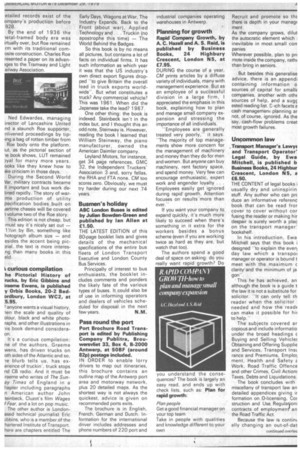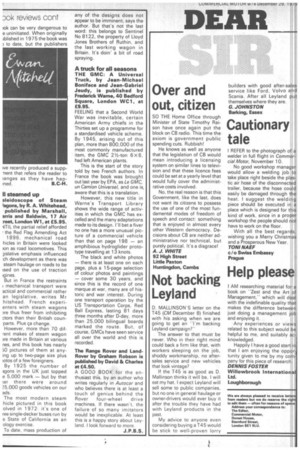RAPID Cal flANY GROUT II-how to plan and manage small
Page 33

Page 34

If you've noticed an error in this article please click here to report it so we can fix it.
company expansion .1.C. Ilazelend. 1.S Rcid you understand the consequences? The book is largely an easy read, and ends up with check lists, such as: Plan for rapid growth:
Plan people Get a good financial manager on your top team
Take in people with qualities and knowledge different to your own
Recruit and promote so thz there is depth in your managr ment As the company grows, dilut the autocratic element which inevitable in most small corr panies Wherever possible, plan to prt mote inside the company, rathr than bring in seniors.
But besides this generalise advice, there is an appendi containing information o sources of capital for smallE companies, another with othE sources of help, and a sugc ested reading list. S.ich facets a cash management planning ar not, of course, ignored. As the say, cash-flow problems creat most growth failures.
Uncommon law
Transport Manager's Lawyc and Transport Operator' Legal Guide, by Ewa Mitchell, is published b Business Books, 24 Highbur Crescent, London NS, a £6.50.
THE CONTENT of legal books i usually dry and uninspirin stuff. Any author who can prr duce an informative referenc book that can be read fror cover to cover without cor fusing the reader or making hir despair is surely worth a plac on the transport manager' bookshelf.
In his introduction, Ewa Mitchell says that this book i designed "to explain the ever day law which a transpoi manager or operator is bound t meet with the maximum c clarity. and the minimum of ja gon".
'This he has achieved, an although the book is a guide t the law it is not a substitute for solicitor. "It can only tell th reader when the solicitor needed and how the readE can make it possible for hi to help.
The subjects covered ar copious and include informatio under the broad headings c Buying and Selling Vehicle5. Obtaining and Offering Supplie and Services, Transport Ins+. rance and Premiums, Emplo) ment, Health and Safety z Work, Road Traffic Offence and other Crimes, Civil Actiom Taxes, Debts and Liquidations.
The book concludes with miscellany of transport law an detailed appendices giving ir formation on 0-licensing, Cor struction and Use. Regulatlionl contracts of employment an the Road Traffic Act.
Because the law is contint ally changing an out-of-dat )ok can be very dangerous to e uninitiated. When originally Jblished in 1975 the book was to date, but the publishers
II steamed up
aleidoscope of Steam ragons, by R. A. Whitehead, published by Marshall, arris and Baldwin, 17 Air :met, London W1, at £5.95.
‘ITIL the partial relief afforded • the Red Flag Amending Act 1896, mechanical road hides in Britain were looked )on as road locomotives. This lislative emphasis influenced ch development as there was steam haulage on roads to be ised on the use of traction igines But in France the restraints mechanical transport were actical and commercial rather an legislative, writes Mr hitehead. French experienters with steam wagons re thus freer from inhibiting ctors than their British coun parts. Plus ca change.
However, more than 70 difeent makes of steam wagon
;re made in Britain at various nes, and this book has nearly 30 pictures of them at anying up to two-page size plus lotos of a few foreigners.
By 1925 the number of igons in the UK just topped e 5,000 mark — but by that iar there were around ?5,000 goods vehicles on our ads.
The most modern steam hide pictured in this book olved in 1972: it's one of ree single-decker buses run by e State of California as an ology exercise.
To date, mass production of any of the designs does not appear to be imminent, says the author. But that's not the last word: this belongs to Sentinel No 8122, the property of Lloyd Jones Brothers of Ruthin, and the last working wagon in Britain. Ifs doin' a bit of road spraying.
A truck for all seasons THE GMC: A Universal Truck, by Jean-Michael Boniface and Jean-Gabriel Jeudy, is published by Frederick Warne, 40 Bedford Square, London WC1, at £9.95.
FEELING that a Second World War was inevitable, certain American Army chiefs in the Thirties set up a programme for a standardised vehicle scheme. By 1945, arising out of this plan, more than 800,000 of the most commonly manufactured item, the GMC 21/2-ton 6 X 6, had left American plants.
This is the start of the story told by two French authors. In France the book was brought Out last year by EPA, as Le GMC, un Camion Universe!, and one is, aware that this is a translation.
However, this new title in Warne's Transport Library shows the wide range of activities in which the GMC has excelled and the many adaptations made to its design. I'll bet a fiver no one has a more unusual picture of a commercial vehicle than that on page 198 — an amphibious hydroglider prototype travelling at 13 knots.
The black and white photos — there is at least one on each page, plus a 15-page selection of colour photos and paintings — cover some 30 years, and since this is the record of one marque at war, many are of historic and war interest. During one transport operation by the US Transportation Corps, Red Ball Express, lasting 81 days three months after D-day. more than 25,000 bilingual boards marked the route. But, of course, GMCs have seen service all over the world and this is recorded.
The Range Rover and LandRover by Graham Robson is published by David & Charles at £4.50.
A GOOD BOOK for the enthusiast this, by an author who writes regularly in Autocar and who believes there is at least a touch of genius behind the
Rover four-wheel drive machines. If there wasn't, the failure of so many imitators would be inexplicable. At least this is a happy story about Leyland. I look forward to more.












































































